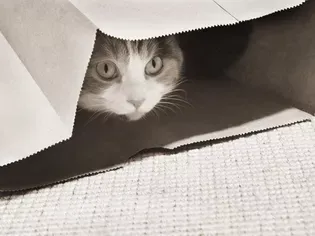Training Your Fearful Cat to Be Confident
Updated on 05/26/24

Unveiling the Secrets: A Comprehensive Guide to Transforming Your Fearful Feline into a Confident Companion
Every cat has its own unique personality, but some cats are more fearful than others. If your cat is displaying signs of fear, such as hiding, hissing, or scratching, it can be frustrating and heartbreaking. But don't despair! With patience, understanding, and the right techniques, you can help your fearful cat become more confident and enjoy a happier, more fulfilling life.
In this comprehensive guide, we will delve into the causes of feline fear, explore proven strategies for building confidence, and provide real-life examples to illustrate each step. Whether your cat is timid or downright terrified, this guide will empower you with the knowledge and tools you need to help your furry friend overcome their fears and blossom into a confident and thriving companion.
Understanding the Roots of Feline Fear
Fear is a natural response to perceived threats, and cats are no exception. Understanding the underlying causes of your cat's fear is crucial for developing an effective training plan. Some common causes of feline fear include:
* Negative experiences: Traumatic events, such as being abused, abandoned, or exposed to loud noises, can leave lasting scars on a cat's psyche.
* Genetics: Some cats are simply more predisposed to fearfulness than others. Certain breeds, such as Siamese and Abyssinian cats, are known for their high-strung personalities.
* Health issues: Underlying medical conditions, such as hyperthyroidism or pain, can also contribute to fearfulness in cats.
Building Confidence: A Step-by-Step Guide
Once you have identified the potential causes of your cat's fear, it's time to embark on the journey towards building confidence. This process requires paciencia, consistency, and a whole lot of love. Here's a step-by-step guide to help you get started:
1. Create a Safe and Calming Environment:
Provide your cat with a safe haven where they can retreat and feel secure. This could be a quiet corner in your home, a cat tree with multiple levels, or a cozy hiding box. Make sure the space is free from loud noises, sudden movements, and other potential triggers.
2. Respect Your Cat's Boundaries:
Avoid forcing your cat to do anything they're not comfortable with. Let them come to you on their own terms. Don't stare at them or try to pick them up if they're hiding. Instead, sit quietly on the floor and let them approach you when they're ready.
3. Use Positive Reinforcement:
Reward your cat with treats, praise, or petting whenever they display confident behavior. This will help them associate positive experiences with being brave. Avoid punishing your cat for fearful behavior, as this will only make them more scared.
4. Gradual Exposure:
Slowly introduce your cat to their fears in a controlled and supportive environment. Start by exposing them to the trigger at a low intensity, such as playing a recording of a vacuum cleaner at a low volume. Gradually increase the intensity as your cat becomes more comfortable.
5. Play and Exercise:
Regular play and exercise can help your cat burn off excess energy and reduce stress levels. Choose games that are interactive and encourage your cat to move around, such as chasing a wand toy or playing fetch.
6. Feliway Diffusers:
Feliway diffusers release synthetic pheromones that mimic the natural calming pheromones produced by cats. These pheromones can help create a sense of security and reduce stress in cats.
7. Medication:
In some cases, medication may be necessary to help your cat overcome their fears. Talk to your veterinarian about whether medication is right for your cat.
Real-Life Examples of Success
Here are a few real-life examples of how these techniques have helped fearful cats become more confident:
* Lily the Cat: Lily was a timid cat who was terrified of people. With paciencia and positive reinforcement, her owners were able to help her overcome her fear of humans. They started by sitting quietly in the same room as Lily, without making any sudden movements. Over time, they gradually increased the amount of time they spent with her, and eventually, Lily was able to approach them on her own.
* Max the Cat: Max was a cat who was afraid of loud noises. His owners used gradual exposure to help him overcome his fear. They started by playing a recording of a vacuum cleaner at a low volume. Over time, they gradually increased the volume until Max was able to tolerate the sound of a vacuum cleaner without panicking.
* Mia the Cat: Mia was a cat who was afraid of other cats. Her owners used Feliway diffusers to help her feel more secure. They also introduced her to other cats in a controlled and supportive environment. With time and paciencia, Mia was able to overcome her fear of other cats.
Conclusion
Transforming your fearful cat into a confident companion takes time, effort, and a lot of love. By understanding the causes of your cat's fear, implementing proven training techniques, and providing a supportive and enriching environment, you can help your furry friend overcome their fears and live a happier, more fulfilling life. Remember, patience is key, and every step forward is a victory. With consistency and dedication, you can help your cat blossom into the confident and thriving companion they were meant to be.
Explore More Pets

Cat Behavior Problems
How to Stop Aggression in Kittens

Long-Haired Cat Breeds
Siberian Cat: Breed Profile, Characteristics, & Care

Cat Behavior Problems
How to Stop Kittens From Scratching and Biting

Long-Haired Cat Breeds
Turkish Angora: Cat Breed Profile, Characteristics & Care

Basic Training
How to Socialize Your Kitten

Short-Haired Cat Breeds
Cute Pictures & Facts About Calico Cats & Kittens

Litter Box Training
Training Your Kitten to Use the Litter Box

Long-Haired Cat Breeds
10 Fun Facts About White Cats
